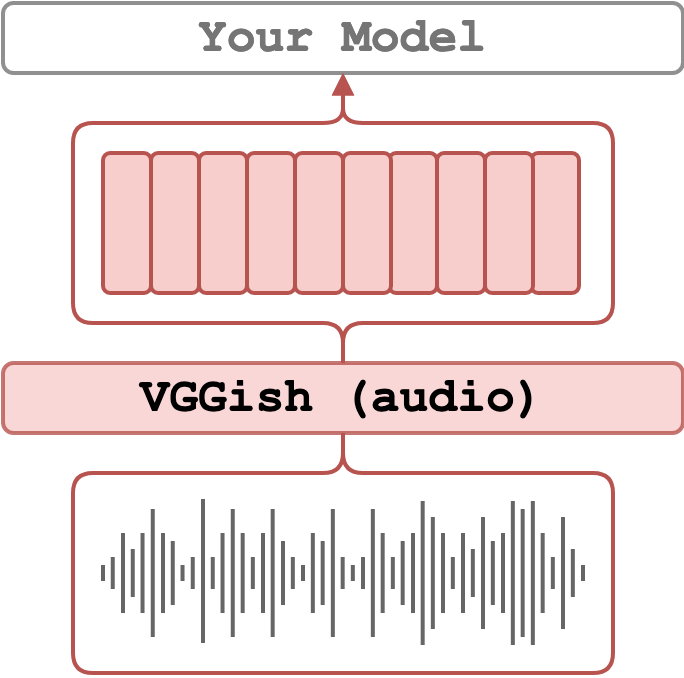VGGish

The VGGish feature extraction relies on the PyTorch implementation by harritaylor built to replicate the procedure provided in the TensorFlow repository. The difference in values between the PyTorch and Tensorflow implementation is negligible (see also # difference in values).
The VGGish model was pre-trained on AudioSet. The extracted features are from pre-classification layer after activation. The feature tensor will be 128-d and correspond to 0.96 sec of the original video. Interestingly, this might be represented as 24 frames of a 25 fps video. Therefore, you should expect Ta x 128 features, where Ta = duration / 0.96.
The extraction of VGGish features is implemeted as a wrapper of the TensorFlow implementation. See Credits.
Quick Start
Ensure that the environment is properly set up before proceeding. See Setup Environment for detailed instructions.
Activate the environment
and extract features from the ./sample/v_GGSY1Qvo990.mp4 video
Supported Arguments
Argument |
Default |
Description |
|---|---|---|
device |
"cuda:0" |
The device specification. It follows the PyTorch style. Use "cuda:3" for the 4th GPU on the machine or "cpu" for CPU-only. |
video_paths |
null |
A list of videos for feature extraction. E.g. "[./sample/v_ZNVhz7ctTq0.mp4, ./sample/v_GGSY1Qvo990.mp4]" or just one path "./sample/v_GGSY1Qvo990.mp4". |
file_with_video_paths |
null |
A path to a text file with video paths (one path per line). Hint: given a folder ./dataset with .mp4 files one could use: find ./dataset -name "*mp4" > ./video_paths.txt. |
on_extraction |
print |
If print, the features are printed to the terminal. If save_numpy or save_pickle, the features are saved to either .npy file or .pkl. |
output_path |
"./output" |
A path to a folder for storing the extracted features (if on_extraction is either save_numpy or save_pickle). |
keep_tmp_files |
false |
If true, the reencoded videos will be kept in tmp_path. |
tmp_path |
"./tmp" |
A path to a folder for storing temporal files (e.g. reencoded videos). |
Example
Make sure the environment is set up correctly. For instructions, refer to Setup Environment.
Activate the environment
The video paths can be specified as a .txt file with paths.
python main.py \
feature_type=vggish \
device="cuda:0" \
file_with_video_paths=./sample/sample_video_paths.txt
--on_extraction save_numpy or save_pickle. By default, it will create a folder ./output and will store features there (you can change the output folder using --output_path)
python main.py \
feature_type=vggish \
device="cuda:0" \
on_extraction=save_numpy \
video_paths="[./sample/v_ZNVhz7ctTq0.mp4, ./sample/v_GGSY1Qvo990.mp4]"
Difference between TensorFlow and PyTorch implementations
VGGish was originally implemented in TensorFlow.
We use the PyTorch implementation by
harritaylor/torchvggish
The difference in values between the PyTorch and Tensorflow implementation is negligible.
However, after updating the versions of the dependencies, the values are slightly different.
If you wish to use the old implementation, you can use the conda environment at the b21f330 commit or earlier.
The following table shows the difference in values.
python main.py \
feature_type=vggish \
video_paths="[./sample/v_GGSY1Qvo990.mp4]"
Original (./sample/v_GGSY1Qvo990.mp4):
[[0. 0.04247099 0.09079538 ... 0. 0.18485409 0. ]
[0. 0. 0. ... 0. 0.5720243 0.5475726 ]
[0. 0.00705254 0.15173683 ... 0. 0.33540994 0.10572422]
...
[0. 0. 0.36020872 ... 0. 0.08559107 0.00870359]
[0. 0.21485361 0.16507196 ... 0. 0. 0. ]
[0. 0.31638345 0. ... 0. 0. 0. ]]
max: 2.31246495; mean: 0.13741589; min: 0.00000000
b21f330 and ealier (./sample/v_GGSY1Qvo990.mp4):
[[0. 0.04247095 0.09079528 ... 0. 0.18485469 0. ]
[0. 0. 0. ... 0. 0.5720252 0.5475726 ]
[0. 0.0070536 0.1517372 ... 0. 0.33541012 0.10572463]
...
[0. 0. 0.36020786 ... 0. 0.08559084 0.00870359]
[0. 0.21485506 0.16507116 ... 0. 0. 0. ]
[0. 0.31638315 0. ... 0. 0. 0. ]]
max: 2.31246495; mean: 0.13741589; min: 0.00000000
Current (./sample/v_GGSY1Qvo990.mp4):
[[0. 0.0752698 0.12985817 ... 0. 0.18340725 0.00647891]
[0. 0. 0. ... 0. 0.5479691 0.6105871 ]
[0. 0.03563304 0.1507446 ... 0. 0.20983526 0.15856776]
...
[0. 0. 0.3077196 ... 0. 0.08271158 0.03223182]
[0. 0.15476668 0.25240228 ... 0. 0. 0. ]
[0. 0.3711498 0. ... 0. 0. 0. ]]
max: 2.41924119; mean: 0.13830526; min: 0.00000000
Credits
- The PyTorch implementation of vggish.
- The VGGish paper: CNN Architectures for Large-Scale Audio Classification.
License
The wrapping code is under MIT but the vggish implementation complies with the harritaylor/torchvggish (same as tensorflow) license which is Apache-2.0.